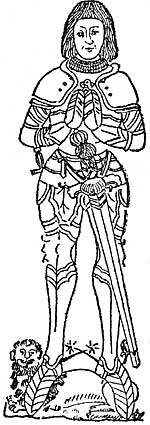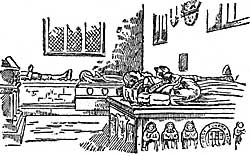
Sir Gervase Clifton.
But though one Sir Gervase stoutly resisted Edward IV., and suffered death for his loyalty, another, the son of Sir Robert Clifton and of Alice his wife, sister of the Archbishop Booth, became a member of Edward's Court, Receiver-General of Notts, and Derby, and surveyor of the King's works and repairs in his Castle of Nottingham, and his lodges of Barkwood Park, and of Clipstone. At the Coronation of Richard III. he was created a Knight of the Bath, and enriched by the grant of several manors in this county. He kept in favour with three successive monarchs of very different temperaments and died in 1491. His will, in the register of Archbishop Rotherham at York, directs his body to be buried in the parish church at Clifton, "To my son Robert Clifton all such stuff of comes as is growyng upon the demeyne lande at Clyfton and ye bedding and oyer stuff of household ther, and a draght of oxen and all my kyne at Clyfton. I will yat liij. li. which is in the handes of my lorde Laurence Booth, late archbishop of Yorke, goodes be emploied and spended for the reparacion and wele of his chauntre and chapel at South well by my executors. * * I will yat all ye lyvelode in Wodehouse besides Northwell which I purchased of Christofor Cokshote be yeven to ye chapitor of Suthwell yif they will take upon theyme the charge of the reparacion of my lorde Laurence chapell for ever more. I require my wiff to fynde a preste for oon yere to pray for my modir soule which I arn bounde to doe." There are many other provisions which we need not quote, but may mention that the bequests include 20s. to the Black Friars of London and to the prior and convent of Blythe three quarters of rye and three quarters of malt. His executors were his wife, Thos. Orston, and Sir Robert Yole, parson of Clifton. In the following century we find another Sir Gervase who held positions of great influence in the reigns of Henry VIII., Edward VI., Mary, and Elizabeth. Thoroton says of him "He proved an excellent person and of great authority in peace and war, and was so courteous that he was styled Gentle Sir Gervase," a designation which is also given him in a well-known distich attributed to Queen Elizabeth (1). His first wife was Mary, daughter of Sir John Nevile, of Chete, in Yorkshire, and there is preserved a curious account of the bride's trousseau and of the expenditure on the wedding feast, which took place on January 17th, 1530. The entries of dress include "6 yards of tawney velvet, every yard 14s.; 3 black velvet bonnets for women, 17s. each; a frontlet of blew velvet, 7s. 6d.; a wedding ring of gold, 12s. 4d.; 12 white hares skinir, 12s.; 12 black coneys skins, 10s.; a paire of mytten sleives of white satin, 14s. 9d.; 2 girdles, 5s. 4d.," and many other items. For the dinner there were purchased 3 hogsheads of wine, £5 5s.; 2 oxen, £3; 12 swans at 6s. each; 8 cranes at 3s. 4d. each; 16 hearonsews at 14d. each; 10 bitterns at 14d. each; 60 couples of coneys at 5d. per couple; 16 capons of geese at 1s. each ; 10 pigs at 5d. each ; 6 calves, 7 lambs, 4 dozen chickens; 2 brawns, &c.; and of spices, which were more costly in those days, large quantities of pepper, ginger, carraways, comfits, orange syrup, and other dainties. A pound of ginger cost 2s. 4d., and sugar was 7d. per lb. Lady Clifton died in 1564, and Sir Gervase took for his second wife Winifred daughter and heiress of William Thwaits, and relict of Sir George Pierrepont, of Holme. The "gentle" baronet died 20th Jan., 1588, and to his memory and that of his two wives there is a fine altar tomb bearing their effigies, and having on one side the figures of three sons who died in childhood, and two daughters.
The eldest son, George, married Winifred, daughter of Sir Anthony Thorold, and died in 1587, in his 21st year. There is a fine brass in the transept with the figures of himself and his wife.

Monuments in Clifton church.
The only son of this young couple, another Sir Gervase, succeeded to the family estates, and was in possession of them during the Civil Wars. He represented the county in Parliament in the time of James I., and was created a baronet by that monarch May 22, 1611. During the reign of Charles I. he was a commissioner for the King at Oxford and at Newark, and according to Thoroton, the most noted person of his time for courtesy." He generously, hogpitably, and charitably entertained all, from the King to the poorest beggar." He married no less than seven wives, the daughters of earls, knights, and esquires, and lived to a great age. Thoroton, who was his physician, and knew him intimately, says, "He was for nearly four score years Lord of Clifton, and his port and hospitality exceeded very many of the nobility." The historian gives the following account of the closing scene of this long and prosperous life:—"He received from me the certain notice of his near approaching death as he was wont to do an invitation of good friends to his own bowling green (one of the most pleasant imaginable), and thereupon immediately called for his old chaplain, Mr. Robert Thirleby, to do the office of his confessor, as if it had been to attend him to that recreation he often used and loved; and when he had done with him, for his children, whom, patriarch like, he particularly blessed and admonished, with the smartness and ingenuity of an excellent and well-studied orator. The day following he received visits from divers friends, in the old dining-room near his bed-chamber, who were not so sensible of his danger, because he entertained them after his usual manner; yet that night (as I easily foretold him) his sleepiness began, which could never be taken away, by reason that both his ureters were so petrified (as things are by the dropping well near Knaresbrough in Yorkshire) that no urine could descend into his bladder, as at the opening of his body did manifestly appear, as also that one of his kidneys had of long time before been totally stopt with a wonderful great stone, as is reported of the pious and learned Dr. Hammond, whose hair was also red like that of this worthy Sir Gervase, who died June 28th, 1666, and was buried the 2nd of August following with great solemnity, Mr. Dugdale (Norroy), Mr. Ashmole (Windsor), and Mr. Ryley (Lancaster), heralds, the Quire of Southwell, and many mourners attending the funeral." By his will he requests that he may be buried near the chancel, and leaves no less a sum than £1,000 for the performance of a funeral suitable to his degree. Much might be written of the lives of succeeding members of the family, and of the last baronet— one of the most genial and popular men who ever represented Nottingham in Parliament, and whose funeral, attended by many thousands of people, was a remarkable manifestation of deep public sorrow—but space does not permit us to follow them further in detail. We pass on to notice briefly the memorials in the church which tell of the great men of whom we have spoken, and of many others who lie buried within the sacred building. In the north transept the monuments are abundant and most noticeable. In the forefront is the large altar tomb bearing the recumbent effigies of a knight in armour and two ladies—Sir Gervase Clifton, who died in 1588, and his two wives, Mary and Winifred. In the background under the north window are two other altar tombs. One bears the effigy of Alice, daughter of Thomas Novell, of Rollestone, wife of the Sir Gervase Clifton, who died in 14-91; and the other, with the figure of a knight in armour, is supposed to be to the memory of her second son Gervase, who married Agnes, daughter of Sir. W. Griffiths, and died June 5th, 23 Henry VII. Placed against the west wall is a curious monument to the memory of the first three wives of Sir Gervase Clifton, the much-married baronet. Beneath a sarcophagus is a representation in marble of a grating containing six skulls and some broken bones. A tablet bears a lengthy inscription. There are numerous floor stones which we need not particularise, but special mention must be made of the brasses, which are very fine. Two of them we have copied, and another has smaller figures—those of George Clifton, Esq., who died in 1587, and his wife Winifred—dressed in the costume of the period. On the chancel walls are several tablets, but the principal memorial is to the venerable Sir Gervase who had seven wives. It is fixed over the doorway leading into the Clifton family vault, and bears a good bust of tbte portly baronet. In the south transept is a floor stoned inscribed to the memory of "Joseph, commonly called the Black Prince, who was converted to the Christian faith Anno Domini 1675, and died on the First Day of June, Anno Domini, 1685, in hope of a better life." The Black Prince was a servant in the Clifton family, and in the church porch are the letters, "I—P," six feet four inches from the ground, said to indicate the height of the stalwart negro.
